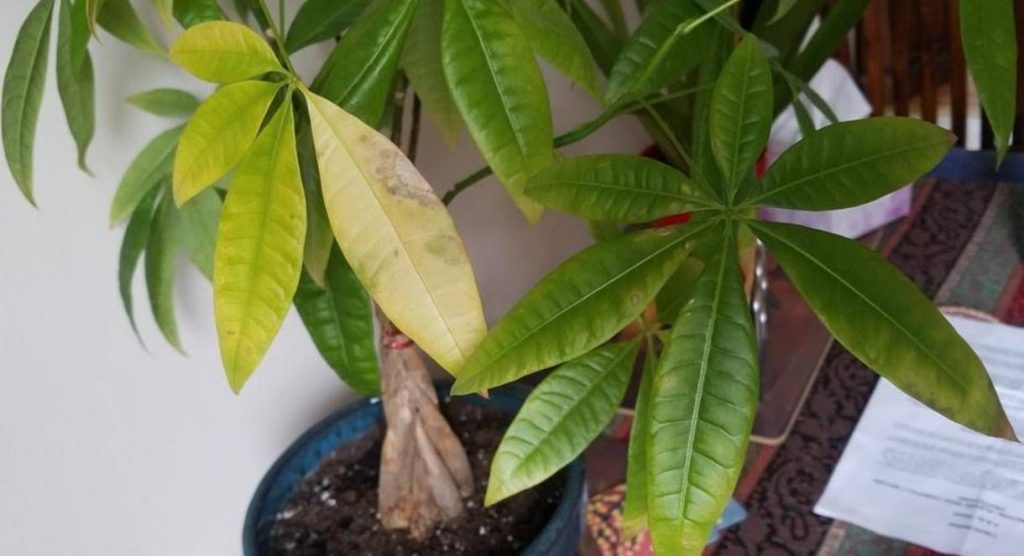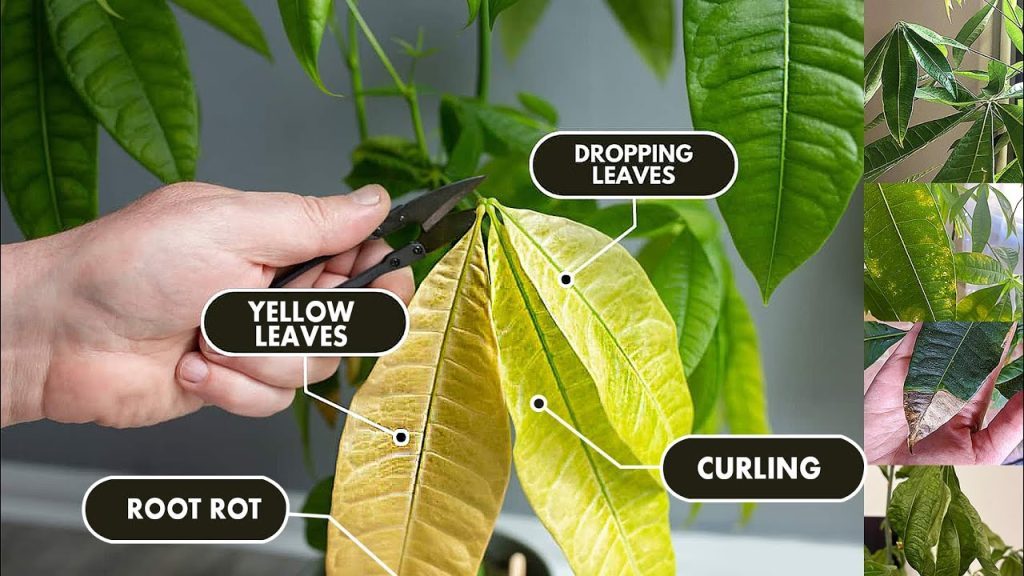- No products in the cart.
Contents hide
The money tree (Pachira aquatica), valued for its palm-like leaves and positive feng shui properties, typically shows signs of stress through money tree leaves turning yellow if it receives too much water or light. Despite this, the money tree remains a low-maintenance and easily propagated indoor plant. Addressing the issue of yellow leaves early is key to revitalizing the health of your money tree.

Why Your Money Tree Leaves Turning Yellow?
Here are six common reasons why your money tree leaves turning yellow:
- Overwatering: Overwatering is a prevalent issue that leads to yellow leaves in houseplants, including the money tree. Excessive watering, using a heavy soil mix, choosing pots without drainage holes, or allowing the plant to sit in waterlogged saucers all contribute to root rot. This prevents the plant from properly absorbing nutrients and water, and if not addressed, it could ultimately kill the plant.
- Excessive Light: Money trees prefer bright, indirect light. Locations that fulfill this requirement, like the feng shui money corner, are ideal. However, too much direct sunlight, particularly from south-facing or west-facing windows, can bleach the leaves, causing yellowish patches to form on the foliage.
- Low Humidity: Native to the humid tropics of Central and South America, money trees flourish in moist environments. Indoor air, particularly in winter, tends to be much drier and can lead to the leaves developing crispy brown edges, eventually leading to wilting and falling off if the humidity is too low.
- Inconsistent Temperature: Money trees are sensitive to temperature fluctuations, especially when placed near heating vents, air conditioners, or drafty windows and doors. They thrive in stable warm temperatures ranging from 65 to 85 degrees Fahrenheit. Variations outside this range can cause the leaves to yellow.
- Pest Infestations: Pests such as spider mites, mealybugs, and scale insects can seriously harm your money tree. These pests drain the sap from the plant, leading to yellowing leaves as a result of the stress and damage they cause.
- Normal Plant Growth: It’s natural for a money tree to occasionally shed an older yellow leaf as it grows. This is part of the normal aging process of the plant. If your money tree continues to produce new growth and there are no other distressing signs, an occasional yellow leaf is generally not a concern.

Addressing Money Tree Yellow Leaves
When yellow leaves on your money tree suggest an underlying issue beyond normal aging, it’s important to quickly identify and address the cause. Regardless of the root problem, use sharp, sterilized pruners or scissors to remove any yellow, brown, or damaged leaves, allowing the plant to focus on healthy growth. Here are ways to treat specific challenges:
Overwatering: Cease watering and let the soil dry out completely before the next watering. In severe cases, repot the plant, excise any decayed roots, and transfer it into fresh soil.
Excessive Light: Should pale spots appear on leaves and your plant resides in a brightly lit area, it may be suffering from sunburn due to excessive light. Relocate the plant to a spot with less direct light or use a sheer curtain to diffuse the sunlight.
Insufficient Humidity: Increase humidity around your money tree by placing it near other plants that love moisture. Alternatively, set the plant on a pebble tray or use a humidifier to moisten the air.
Fluctuating Temperatures: Move your plant to an area with more stable temperatures, away from drafty windows, doors, and air vents.
Pest Infestations: Look for signs of pests such as flat brown spots and sticky residue on leaves (indicative of scale), cotton-like clusters (mealybug eggs), or fine webs (spider mites). Isolate the plant, cover the soil, and wash the pests from the leaves with water. Apply neem oil as a preventive measure. Remove heavily infested parts of the plant and keep it isolated until it recovers.
Preventing Money Tree Yellow Leaves
To prevent your money tree’s leaves from turning yellow, provide consistent care and maintain proper growing conditions. Monitor for pests regularly and address any issues promptly to prevent them from worsening. Remember, the occasional yellow leaf on an otherwise healthy money tree is typically not a cause for concern.
FAQs
Can Yellow Money Tree Leaves Regain Their Green Color?
Once a money tree leaf turns yellow, it permanently loses its chlorophyll and cannot turn green again. However, addressing the underlying issue will promote the growth of new, healthy green leaves in its place.
How Frequently Should You Water a Money Tree?
You should water the money tree whenever the top inch of soil feels dry. The tree requires more frequent watering during the spring and summer months compared to the fall and winter. Tap water is sufficient; there is no need for distilled water.
How to Determine if a Money Tree is Overwatered or Underwatered?
Typically, yellow leaves suggest that the money tree has been overwatered. In contrast, underwatering is indicated by leaves that curl and discolor, often turning brown.
What Amount of Sunlight is Ideal for a Money Tree?
A money tree thrives with at least six hours of bright to medium indirect sunlight daily.
Read more:

